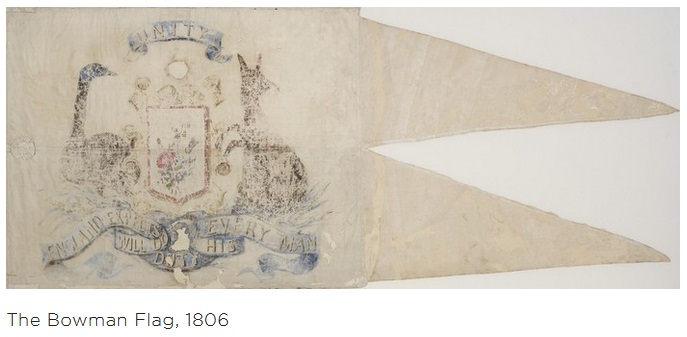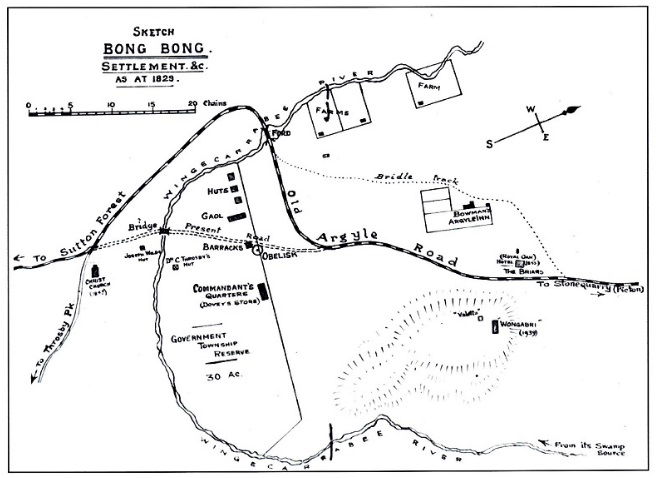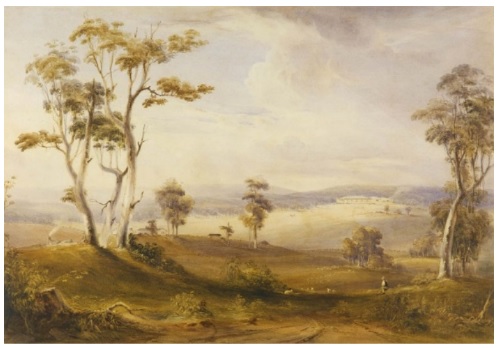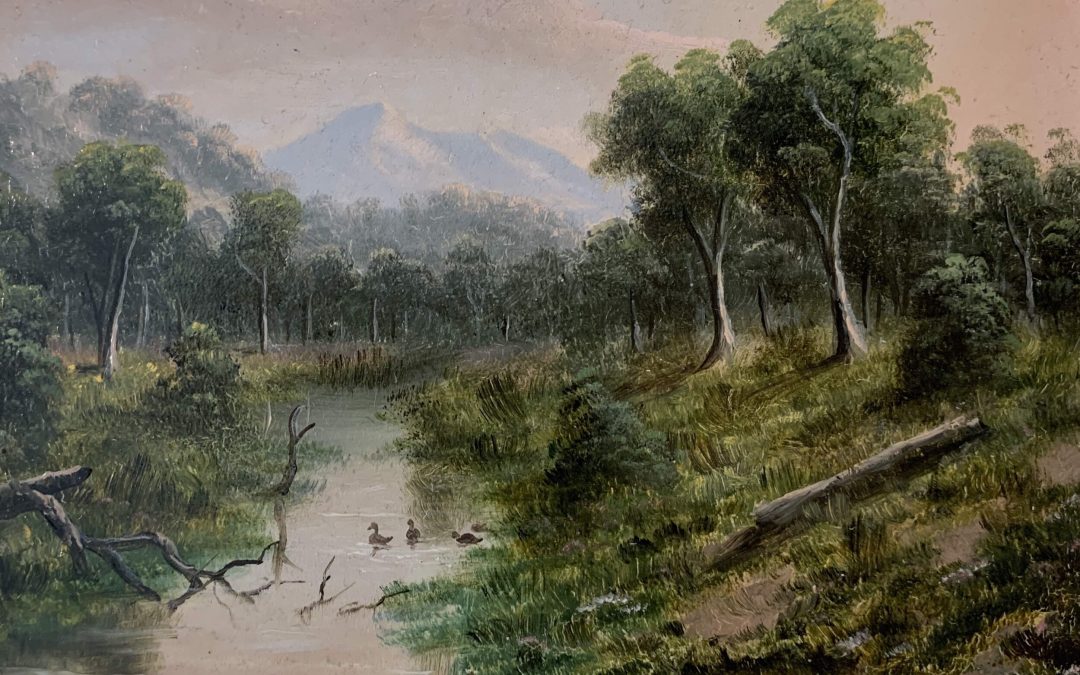Oil Painting by Alfred William Eustace, possibly near Beechworth or Bright c1880
In 1837 William Bowman took up Sutton Grange Station at Mount Alexander close to present-day Castlemaine and had as his neighbour, William Henry Yaldwin of Barfold station near Kyneton. (1) Both Bowman and Yaldwin’s shepherds were convict ticket of leave men who were, as John Coppock, Yaldwin’s overseer wrote, an ‘unmitigated band of ruffians, and at times were very difficult to control, and required a good deal of management.‘ John Coppock knew his men shot Aboriginal people on sight (2) and this indiscriminate killing may have led to the attack where 23 Djadjawurrung people were killed. This slaughter is known as the Waterloo Plains massacre. (1)
After the massacre, William Bowman sold Sutton Grange and took up Tarrawingee station near Beechworth in northeast Victoria. (3) William Bowman had an expressed hatred of Indigenous people and shot them wherever he saw them. (4) His stockman, Benjamin Reed was also a known killer of Indigenous persons. GA Robinson later wrote Reed, ‘has had several collisions with the natives, it is feared many have been of a fatal character to the aborigines.’ (5)
William Bowman built a fine home called The Grange at Everton near Tarrawingee and lived there until selling to Dr Mackay in 1851 Trove article 13th May 1939
Tarrawingee was Merriman’s land (6) and the arrival of Benjamin Reed in 1838 led to a feud between the two. (7) The animosity between Merriman and Benjamin Reed led to a series of incidents culminating in the death of Merriman’s brother Harlequin and the loss of Benjamin Reed’s ticket of leave. (8) (9)
William Bowman was the son of free settlers who arrived in the colony when William was about 4 years of age in 1801. He became a wheel-wright and agricultural implement maker with premises in George Street, Sydney. (10)
According to the Australian Dictionary of Biography, William Bowman was the nephew of John Bowman (1763-1825), settler, came from East Lothian, Scotland, and was a carpenter experienced in building corn-mills. Bowman was interviewed on the recommendation of Sir Joseph Banks in London in 1797 and then sent for by NSW Governor King. He secured a free passage to New South Wales and arrived in the Barwell in May 1798 accompanied by his Cornish wife Honor, née Honey, a son and a daughter. John Bowman sailed with John Smith of Edinburgh and Andrew McDougall who were all carpenters commissioned to build a corn mill in Parramatta to help with the colony’s food supply. Hardwick family history
On completion of the mill John Bowman was granted 100 acres (40 ha) at the Hawkesbury and, apparently pleased by his new surroundings, urged his brother William to migrate to the colony. William reached Port Jackson in the Nile in December 1801 with his son, William Bowman of Bong Bong (1798?-1848). (10.1)

The Bowman Flag is believed to be the first flag designed and made in colonial Australia, and it is also the first known use of the kangaroo and emu as symbols of Australia. The flag was probably designed by John Bowman and sewn by his wife, Honor, and daughter, Mary, in 1806 to fly at their farm Archerfield near Richmond, NSW. It was created to celebrate the victory of Lord Horatio Nelson and the British fleet at the Battle of Trafalgar on 21 October 1805.
According to the Bowman family, the flag was made from Honor Bowman’s wedding dress. It was cut and sewn either by Mary (aged nine at the time), John Bowman’s daughter, or by Honor, his wife. Perhaps by both. It is unlikely that Mary or Honor Bowman painted the image, which appears to be the work of a professional sign painter using oil colours probably sourced from India or China. Information regarding the flag is from the State Library NSW. State Library NSW
1824 William Bowman married Elizabeth Hutchinson, the daughter of William Hutchinson. (11) William Hutchinson had arrived in the colony as a convict but had become incredibly wealthy and held great influence in the colony. (12)
In 1825 William Bowman obtained a land grant at Bong Bong for an inn to accommodate travellers and erect a wheelwright and blacksmith shop to accommodate the needs of passing travellers. (13) His wealthy father-in-law would have been immensely helpful in Bowman’s plans.
William Bowman’s “Argyle Inn” is by the bridle and the Old Argyle Road – see below

This sketch is based on the memory of Miss Sarah Gregg Loseby, who was born at nearby ‘Harby Farm’ on 4 September 1847 and still had a ‘clear memory’ in her 100th year when the commemoration ceremony was held on 18 January 1947. (29)
In 1827 William Bowman built an inn above the Wingecarribee River, in what is now the Bong Bong Common between Mittagong and Bowral. His wife, Elizabeth Hutchinson was described as a dashing hostess by a traveller who wrote an article praising Bowman’s inn in 1832. ‘the town, which has only one redeeming feature-a first rate house of entertainment, “The Argyle Sun,” kept by Mr. W. Bowman. This rest for the weary is conducted on a most respectable scale, and with its dashing Hostess forms an agreeable insipidity of the dullest of dull settlements.’ (14)

This view of Throsby Park by Conrad Martens, c1836, indicates how the original
landscape around the Bong Bong township may have looked
In 1832 Bowman sold the licence to Richard Loseby for eighty quid and it is reported Loseby made around 600 pounds in the first year. (13)
In 1837 May 27th The Sydney Gazette wrote that Mr Bowman of Bong Bong had lost 3,000 sheep from a disease prevalent in that district. It is likely the sheep were diseased with catarrh or influenza which could decimate a flock in days. Perhaps it was the prevalence of catarrh in the Yass area in 1837 or perhaps it was excitement from reports of abundant water and wide grasslands south of the Murray River that prompted Bowman to become an overlander. Either way, he would have been well-financed by his father in law who was one of the wealthiest men in the colony.
In January 1838, Capt. John Hepburn met Bowman at the Murrumbidgee. They travelled southwards and at the Murray River, Hebburn wrote they crossed successfully, ‘Mr. Bowman had about 5,000 sheep, Mr. Coghill 2,000, making, with Hepburn’s lot, in all near 9,000; from our arrangements, we crossed the whole of the sheep in 2.5 hours without the loss of a single sheep.’ (14.1)
1st March 1838 they came upon a group of Indigenous people near the Goulburn River. Capt. Hepburn wrote they saw a flock of white parrots and; ‘Having my gun in my hand, I fired both barrels, and by good chance shot two. This occurrence gave alarm to my sable brethren. All disappeared, but only for a short time. They appeared in much larger numbers than we had seen before; they examined the guns with great curiosity and wanted to see me fire again, which I declined. However, Mr Bowman gratified them.’ (15)
In late March 1838, William Bowman took up land at Mount Alexander calling it Sutton Grange station. It was located 20 miles northeast of Mount Macedon. Within weeks of arriving at Sutton Grange, William Bowman began having trouble with the local Indigenous people. According to the Melbourne Court Register, 21st April 1838 (2 weeks after the Faithful massacre), Bowman made a sworn statement where he complained the Blacks had intimidated his men to the point he was having trouble making them go out to work. (16)
On 11th April 1838, eight of WP Faithful’s shepherds were killed at the Broken River. At this time William Bowman was in the area to establish a station. According to Dr George Mackay who arrived on the afternoon of the massacre at Myhree to establish a station, there were two temporary encampments previous to his arrival. Mr William Bowman and Col Henry White. Dr Mackay said a panic then seized the servants and they deserted their employees. Bowman, White and Faithful abandoned their cattle on their runs. Dr Mackay also left the area and overwintered at Noorongong. When Dr Mackay returned six months later (late September or October) Myhree had been taken up by J W Chisholm, Faithful was at the Oxley Plains and Bowman was at Tarrawingee. Letters from Victorian Pioneers, #37.
Just a few weeks later, on the 19th of May, a shepherd named Thomas Jones (ship; Westmoreland 1834) was found murdered on Bowman’s station. He was found with spears sticking out of him and his stomach open. William Lonsdale unofficial Superintendent in Melbourne said the man was killed by Blacks but not of those from this part of the country (17)
In June 1838, a letter to the editor was published in the Colonist making it clear that if the government would not stop Indigenous people interfering with farming activities in the area near William Bowman, the squatters would take matters into their own hands by, ‘forming a sort of militia corps, consisting of every hut-keeper, watchman, and stockman, able to shoulder a musket, in order that we may thus be enabled to repel force by force.’ (18)
The author used the alias, STRATA UMBRA and was well informed of incidents between Indigenous people and squatters on the Broken and Campaspe Rivers. He used the licence fee paid by squatters as a reason for the government to provide assistance in quelling any retaliation by Blacks against squatters intruding on their land. ‘the Government, after having pocketed 10 pounds from each of us for license to depasture our flocks and herds….a small sum I admit…but they are the pioneers of civilization.’ (18)
The letter goes on to complain of the ineffectiveness of some thirty troopers sent to assist, ‘these men are strictly prohibited from resorting to “any means of retaliation.” No discretionary power has been given to them. They are not even allowed to shoot the blacks who were concerned in the massacre of Mr Faithful’s men.’ (18)
The author was incensed that the government wanted to bring the Blacks responsible for the Faithful massacre to trial rather than kill them outright. ‘So anxious has the Government been about the safety of the natives, that Mr Stewart, the Police Magistrate at Goulburn, was despatched in order to prevent the party sent under the command of Lieutenant Waddy, in pursuit of the murderers of Mr Faithful’s men, from hurting any of the blacks. The mounted police are instructed to apprehend them and bring them to trial.’ (18)
Part of the author’s frustration was the superior bush skills of the Blacks, ‘Unless their pursuers are invested with a discretionary power to shoot them, these nimble fellows could easily elude a whole regiment of cavalry.’ (18)
The author writes of the killing of William Bowman’s shepherd, Thomas Jones saying, ‘that at this moment there are about twenty muskets in the possession of one tribe near the Murray…They have recently committed two more murders; one of these unfortunate victims was a shepherd belonging to a gentleman (Mr. Bowman),’ (18)
The writer suggests the Blacks in possession of the guns are the ones responsible for the murder of Jones and goes on to speak of the atrocity committed by some squatters of mixing arsenic with damper and leaving it where the Blacks might find it. The mention of arsenic is written as a horrendous thing to do but by suggestion, it is an act that has taken place and will be continued while squatters feel threatened. (18)
The author then makes a truly appalling assertion saying, ‘that, until the government see the necessity of giving the mounted police already despatched discretionary powers to shoot a few of the blacks who commit outrages among the stations, the proprietors themselves should, by forming a militia corps, follow the example of Major Mitchell.’ (18)
The example regarding Major Mitchell shows the arrogance of the squatters regarding their rights compared to the rights of the traditional owners of the land. Major Mitchell’s massacre of indigenous persons at Mount dispersion near Mildura in 1836 was an outrage. The area was known for thousands of years to the Kureinji and Barkindji people for its sacred association with Dreamtime stories. Mitchell became frightened when he saw Indigenous men women and children gathered near the river and ordered his men to shoot. Mitchell’s men fired on the Indigenous people as they escaped across the river and climbing the other side of the bank. It was described as, ‘a bloody and vicious event.’ Major Mitchell was later reprimanded by his superiors for not keeping a cool head. (19)
The letter goes on to insist squatters be allowed to, ‘shoot a few of their ring-leaders…There is no other way of convincing them of the superiority of the whites.’ (18)
On the 9th June 1838, shepherds reported a flock belonging to Bowman and another belonging to his neighbour Yaldwin of Barfold station had been taken by the Blacks. A massacre of indigenous people then followed with Bowman and Yaldwin afterwards claiming they had to enter into battle to recover the sheep. This became known as the Waterloo Plains massacre led by John Coppock, Yaldwin’s overseer. (20)
Bowman and Yaldwin both claimed they had given no reason for the Blacks to steal their sheep. Yet Yaldwin’s overseer, John Coppock later said his men, ‘were in the habit during his absence of shooting down the blacks on sight; they did not confine themselves to men, but destroyed the lubras and piccaninnies as well.’ (21)
Nor was it mentioned that Bowman practised the same appaling behaviour. Assistant Protector ES Parker’s report to Robinson, dated 20 June 1839, claimed that Bowman was in the habit of shooting every black man, woman or child whom he met on his run. (Robinson papers) (4)
On the 16th of August one of William Bowman’s stockmen, Benjamin Reed found the body of George Graham (per Hero). George Graham had failed to return to the hut at the end of the day and it was assumed he had succumbed, ‘to a fit of which disorder he was subject to.’ (22) A search party of Benjamin Reed and James Crossley (overseer of WP Faithful) found the body in a water hole two miles from the head station. By the wounds on the body, it was believed George Graham was killed by indigenous people. But since both Reed and Crossley were known to each other, both having arrived in the colony aboard the same convict ship, Katherine Stewart Forbes, (23) and both had reason to wish harm to indigenous people – did they tamper with the body to make it appear as though Graham was killed by Blacks?
After the Waterloo Plains massacre, William Lonsdale said, ‘I am inclined to think these blacks are some of those who were concerned in the attack upon Mr Faithful’s party, and they have for some time past been very troublesome in the country about Mr Yaldwin’s station?’ (24)
By September 1838, William Bowman had left the area taking Benjamin Reed with him. He sold to Edward William, or William Umphelby, as he was more often called. Umphelby brought William Bowman’s stock and grazing run on the Coliban in late 1838 or early 1839. He arranged a virtual exchange with William Bowman and took possession of Bowman’s sheep station on the Coliban River. In return, he gave Bowman a Mortgage and power of sale over the Angel Inn. There appears to have been very little difference in the estimated values of the hotel and the sheep station. (25)
On 13th September 1838 William Bowman attended a land sale in Melbourne and purchased a town lot for £136. Discovery & Settlement of Port Phillip by Bonwick
William Bowman quickly established himself at Tarrawingee. His stockman, Benjamin Reed led David Reid (no relation) to the fertile north banks of the Ovens River known as Carraragarmungee. David Reed set up a station there and thus had William Bowman as his neighbour. (26)
In November 1839 William Bowman’s stockman, Benjamin Reed received his ticket of leave and married Mary Godfrey then brought her to live with him at Tarrawingee. (27)
In May 1840 Benjamin Reed and his wife were staying across the Ovens River at Dr George Mackay’s Whorourly station when Merriman and 20 of his fellows came to the hut and demanded Mary Reed be handed over to them. The siege ended with the death of a hut keeper. (26)
William Bowman does not seem to have had any further altercations with Indigenous people but perhaps that was because they had already been subdued by force. Bowman built a homestead which was the first in the district to have glass in the windows and a wooden floor, and about the beginning of 1842, he brought his family to ‘Tarrawingee’, being the first settler in the district to do so. (10)
In 1844 William Bowman’s health deteriorated to the point he invited an old family friend, Dr Arthur Huffington, an old family friend to join them at Tarrawingee and help care for him.
In June 1844 a series of letters appeared in the newspapers between George Faithful who was Bowman’s neighbour over the Ovens River and Dr Huffinton who was overseer for Bowman. George Faithful claims Huffington placed Bowman’s brand on Faithful’s cattle. Port Phillip Gazette (Vic. : 1838 – 1845 Sat 15 Jun 1844 Page 3 JUDICIAL INTELLIGENCE.
In November 1846, William Boman sold ‘Tarrawingee’ station to Dr. (later Sir) Francis Murphy, who erected a brick house.
William Bowman died on 20th October 1848, as a result of a carriage accident in the Blue Mountains. He was 50 years of age and was buried in the graveyard of St. Bartholomew’s Church in the outer Sydney suburb of Prospect, near Parramatta. (10)
Two months later Dr Huffinghton married Bowman’s widow, Elizabeth, on 16th December 1848 at Sydney. (10)
Elizabeth died less than a year later on 30th August 1849.
On 20th December 1853 ‘Tarrawingee’ was purchased by Dr. George Edward Mackay, who had overlanded cattle to Port Phillip early in 1838. Tarrawingee Pre-emptive Right of 640 acres, on which the homestead was situated, was purchased by Dr. Mackay for one pound per acre under the government regulations of 28th June 1850, the grant from the crown being dated 18th August 1859.
According to Port Phillip Pioneers Group William and Elizabeth Bowman had a number of children
Their first child was a son named William Mackenzie, who unfortunately died on 24th March 1825 aged four months.
- Emma Eliza born 14th December 1825 at Sydney.
- Helen Sarah Ann born 25th January, 1828 at Bong Bong. Her father then kept the ‘Argyle Inn’ at Bong Bong.
- Mackenzie born 29th July 1836 at Sydney. There were no children born between 1828 and 1836.
- Frederick William born 15th January 1839 at Bong Bong.
- Leslie Edgar born 21st June 1840 at Bong Bong.
- Alfred Hutchinson born 14th September 1841 at Bong Bong.
- William Henry born 18th October 1843 at ‘Avoca’, Yarra River, Melbourne. His father was described as a Settler, of Ovens River.
- Arthur Charles Macquarie born 18th November 1844 at ‘Tarrawingee’, Ovens River. He was not baptised until 7th April 1849 at Sydney.
Their daughter, Helen Sarah Ann was said to be a beautiful looking girl who had many admirers. She married Jephson Busteed Quarry an Irish solicitor in 1844, she was 14 years old. Scarcely three months after the marriage she cut a vein in her arm and took a dose of laudanum but survived. Her husband, according to Georgiana McCrae was a unattractive man with pale white skin and black hair who had a pugnacious temper. Mrs Helen Quarry survived and went on to have many suitors and was still beautiful in later life. (28)
William Bowman is sometimes referred to as Dr William Bowman but I have found no evidence he was anything other than a publican, wheelwright and landowner. However, there was a Doctor William Bowman at Richmond, Sydney during the same period and while they may have been related, they were different people.
THE REFERENCES;
*Photo; Meal time, Downland Shepherd, Sussex, c.1930s
(1) Clark, Ian D. (1995). Scars in the landscape : a register of massacre sites in western Victoria, 1803-1859. Canberra: Australian Institute of Aboriginal and Torres Strait Islander Studies. ISBN 0-85575-281-5. OCLC 41539940.
(2) John Coppock, “Old Time Memories: Trials and Experiences of a Pioneer,” “The Australasian,” 31 October 1885, courtesy of the National Library of Australia, Trove. https://trove.nla.gov.au/newspaper/page/11302442#
(3) AA Andrews, First Settlement of the Upper Murray
(4) Assistant Protector ES Parker’s report to Robinson, dated 20 June 1839, claimed that Bowman was in the habit of shooting every black man, woman or child whom he met on his run.
(5) Brit Parli Papers, GA Robinson letter reporting Benjamin Reid as a killer of Indigenous people. Brit Parli Papers, Enclosure 2, in No. 25. Chief Protector’s Office, Melbourne; 27 February 1841
(6) GA Robinson, Journal 1839-52, 23rd February 1841. pg 269. Merriman’s ground is Tarrawingee.
(7) Feud between Merriman and Benjamin Reed is mentioned in Ogiers reminiscences of David Reid & The Two Lives of Joseph Docker, J.M. McMillan, pg 176 & Brit Parli papers, End. a, in No. 25. GA Robinson, Chief Protector, 27 February l841. To His Honor Charles Joseph La Trobe.
(8) Death of Harlequin by cruel treatment, GA Robinson journal, pg 236, Thursday 10th December 1840.
(9) Request for Benjamin Reed to have ticket of leave revoked. Brit Parli Papers, No. 25 from Sir George Gipps to Lord John Russell. Sydney, 9 April 1841.
(10) Port Phillip Pioneers Group, by Ken Smith ( PPPG Member No. 895 ) Port Phillip Pioneers Group Website also see William Bowman’s Death Notice in Sydney Morning Herald
From ‘Australians 1838’ pp, 50-2
(10.1) John Bowman, uncle of William Bowman
(11) Australian Royalty, https://australianroyalty.net.au/tree/purnellmccord.ged/individual/I67360/Elizabeth-Hutchinson
(12) see the profile of William Hutchinson on this website.
(13) History of Bong Bong with info on William Bowman https://www.southernhighlandnews.com.au/story/3843450/our-first-township-had-a-cracking-pub/
(14) Letter from a Traveller. https://trove.nla.gov.au/newspaper/article/2205587?searchTerm=Bong%20Bong%2C%20inn%2C%20first%20rate%20house%20of%20entertainment%201832#
(14.1) https://trove.nla.gov.au/newspaper/article/28653248#
(15) Letters From Victorian Pioneers’ pg 53. Capt John Hepburn
(16) Killing of Bowman’s shepherd, Thomas Jones, Historical Records of Victoria Vol 2A pg 336
(17) Historical Records of Victoria Vol 2A pg 336
(18) Letter to the Colonist, dated 30th June 1838. the squatters would take matters into their own hands
(19) Major Mitchell ordered the massacre at Mount Dispersion
(20) Colonial Frontiers Massacre Map; https://c21ch.newcastle.edu.au/colonialmassacres/detail.php?r=507
(21) John Coppock, “Old Time Memories: Trials and Experiences of a Pioneer,” “The Australasian,” 31 October 1885, courtesy of the National Library of Australia, Trove. John Coppock’s letter
(22) Historical Records of Victoria: Vol 2A, pg 334. Death of George Graham
(23) See profile on this site of James Crossley and Benjamin Reed for more information
(24) Lonsdale believes Blacks responsible for Faithful massacre attended Yaldwin’s station, Historical Records of Victoria: Vol 2A, pg 340
(25) Umphelby Family History, pg 8 of 59. & 10 of 59 https://forsterfamily.files.wordpress.com/2013/10/the-umphelby-family.pdf
(26) Ogiers reminiscences of David Reid
(27) Benjamin Read married Mary Godfrey in Sutton Forest (adjacent to Bong Bong) She was 22 and Read was 31. She died 5/9/1860 at Bong Bong. Her father was William Gordon Godfrey and her Mother was Mary.
(28) Georgiana’s Journal, Melbourne 1841 – 1865 Edited by Hugh McCrae
(29) From; Bong-Bong-Common-Booklet-2021


